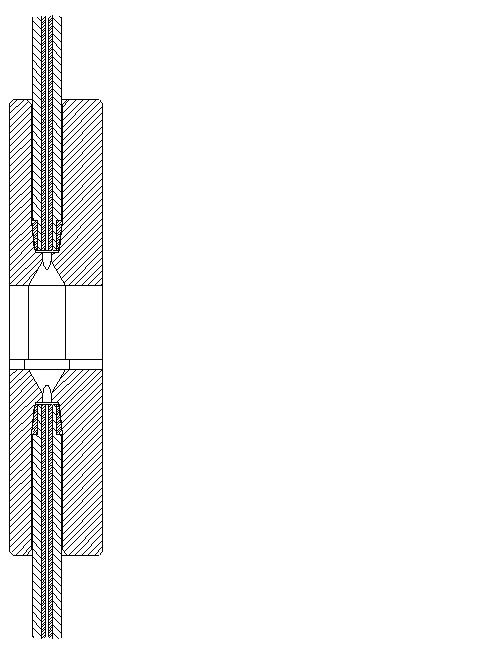Optical Unit
All the elements of the optical system, shown in Optical Unit, including Xenon flash lamp, excitation condenser lens, excitation slit, mirror, excitation grating, flow cell, emission condenser lens, cut-off filter, emission slit, emission grating and photo-multiplier tube are housed in the metal casting inside the detector compartment. The fluorescence detector has grating/grating optics, enabling the selection of both excitation and emission wavelengths. The flow cell can be accessed from the front of the fluorescence detector.
The radiation source is a xenon flash-lamp. The 3 µs flash produces a continuous spectrum of light from 200 nm to 900 nm. The light output distribution can be expressed as a percentage in 100 nm intervals, see Lamp Energy Distribution (vendor data). The lamp can be used for some 1000 hours depending on the sensitivity requirements. You can economize during automatic operation using keyboard setpoints, so the lamp flashes during your analysis only. The lamp can be used until it no longer ignites, but the noise level may increase with usage.
UV degradation, especially below 250 nm is significantly higher compared to Visible wavelength range. Generally the "LAMP ON during run" - setting or using "economy mode" will increase lamp life by a magnitude.
The radiation emitted by the lamp is dispersed and reflected by the excitation monochromator grating onto the cell entrance slit.
The holographic concave grating is the main part of the monochromator, dispersing and reflecting the incident light. The surface contains many minute grooves, 1200 of them per millimeter. The grating carries a blaze to show improved performance in the visible range.
The geometry of the grooves is optimized to reflect almost all of the incident light, in the 1st order and disperse it with about 70 % efficiency in the ultra-violet range. Most of the remaining 30 % of the light is reflected at zero order, with no dispersion. Dispersion of Light by a Grating illustrates the light path at the surface of the grating.
The grating is turned using a 3-phase brushless DC motor, the position of the grating determining the wavelength or wavelength range of the light falling onto the flow cell. The grating can be programmed to change its position and therefore the wavelength during a run.
For spectra acquisition and multi-wavelength detection, the grating rotates at 4000 rpm.
The excitation and emission gratings are similar in design, but have different blaze wavelengths. The excitation grating reflects most 1st order light in the ultra-violet range around 250 nm, whereas the emission grating reflects better in the visible range around 400 nm.
The flow cell is a solid fused silica body with a maximum back pressure of 20 bar. Excessive back pressure will result in destruction of the cell. Operating the detector close to waste with low back pressure is recommended. A slit is integrated to the body.

The luminescence from the sample in the flow cell is collected at right angles to the incident light by a second lens, and passes through a second slit. Before the luminescence reaches the emission monochromator, a cut-off filter removes light below a certain wavelength, to reduce noise from 1st order scatter and 2nd order stray light, see Dispersion of Light by a Grating.
The selected wavelength of light is reflected onto the slit in the wall of the photo-multiplier compartment of the optical unit. The bandwidth of the emitted light is 20 nm.
On the photocathode, Photo-multiplier Tube, incident photons generate electrons. These electrons are accelerated by an electrical field between several arc-shaped dynodes. Depending on the voltage difference between any pair of dynodes, an incident electron may spark-off further electrons which accelerate onto the next dynode. An avalanche effect results: finally so many electrons are generated that a current can be measured. The amplification is a function of the voltage at the dynodes and is microprocessor controlled. You can set the amplification using the PMTGAIN function.
This type of so-called side-on photo-multiplier is compact ensuring fast response, conserving the advantages of the short optical path shown in Optical Unit.
PMTs are designed for specific wavelength ranges. The standard PMT offers optimum sensitivity from 200 to 600 nm. In the higher wavelength range a red-sensitive PMT can improve performance.
Subpages
base-id: 3586871691
id: 3586871691